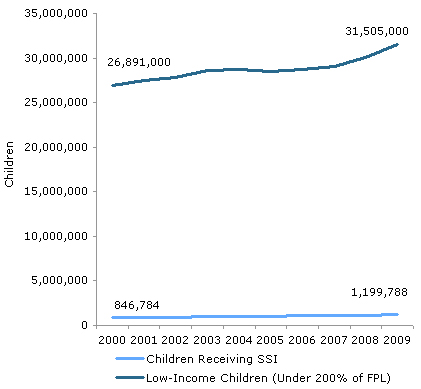October 05, 2011
Signed into law by President Nixon, Supplemental Security Income provides basic income supplements to adults and children who have severe disabilities and limited resources. The number of children with disabilities who are SSI beneficiaries is quite modest: about 1.2 million nationally in 2009, compared with 31.5 million children total in low-income households. But for these children the help SSI provides is extremely important.
Research has shown that families caring for children with disabilities are more likely to experience various economic hardships than families caring for non-disabled children, even controlling for income. This is no surprise since caring for children with disabilities is expensive, health insurance doesn’t cover many added expenses, and raising a child with a disability can take a considerable physical, emotional and financial toll on parents. Research conducted by Mark Duggan and Melissa Schettini Kearney has shown that increases in the receipt of SSI by disabled, low-income children are “associated with a significant and persistent reduction in the probability that a child lives in poverty of roughly eleven percentage points” without reducing parental employment. In short, the hard evidence shows that SSI is a small program that works well.
So I was surprised when at a recent AEI forum, conservative Ron Haskins made the following claims about Supplemental Security Income for children:
…. this is the problem we’ve had historically for more than three decades now, a problem of more and more and more kids getting on SSI … SSI was flawed from the beginning … it was intended to help people who couldn’t work, well we don’t expect kids to work, so we have a conceptual problem from the beginning … we still haven’t got a good solution ….
There are at least two problems with Haskins’ claims. First, as the legislative history of SSI shows, Congress intentionally decided against excluding disabled children from SSI. Here’s language from the House Ways and Means Committee’s Report on the legislation:
Disabled children living in low-income households are among the most disadvantaged of all Americans and are deserving of special assistance …. [P]oor children with disabilities should be eligible for SSI benefits because their needs are often greater than nondisabled children.
The facts supporting this basic Congressional justification for SSI, haven’t changed as the research cited above shows. There is simply no “conceptual problem” with providing supplemental support to parents who are caring for low-income children with disabilities. There are questions of design, of course. For example, how to structure the benefit so that low-income parents aren’t forced to quit their jobs in order to get help for their children, while also recognizing that the best interests of some disabled children are best served by making it possible for parents to stay home to care for them, or to work a reduced schedule. But claiming there is a fundamental conceptual problem with providing assistance to disabled children because “children don’t work” doesn’t help answer these design questions.
Second, if one believes, as Haskins appears to, that too many low-income disabled children receive SSI today, it’s not sufficient to simply point to trend data showing that the number of disabled children receiving SSI benefits went from zero in 1971 before the program was implemented to 1.2 million children some four decades later. This is a bit like saying that the Social Security program is a “problem” because the number of retirees and disabled people receiving benefits has gone from zero in 1935 when the program was established to 52.5 million today.
A better question for Haskins to ask would be: Given what we know about the number of low-income children with disabilities, is the number of children who currently receive SSI too high, too low, about right, or do we not know enough to make a judgment right now? In a recent presentation, Rebecca Vallas and I reviewed data available on this question, and concluded that it’s probably either too low or about right. Haskins may read that evidence differently than us, but he should read it and make a judgment about it.
While it is true that “more” children are receiving SSI than 40 years ago, or to bring it a bit more within a reasonable time frame, than 10 years ago, it’s also true that : 1) there are “more” children living in low-income households than 40 or 10 years ago, 2) there have been considerable improvements in the early identification of child disabilities, and 3) the number of low-income children who have received early screening and diagnostic treatment services through Medicaid have more than tripled over the last decade. These factors need to be taken into account in any assessment of trends in children’s SSI receipt. As a practical matter, as the chart below shows, the number of disabled children receiving SSI is only a small share of the number of low-income children overall. While the share of low-income children who receive SSI has increased slightly—from 3.15 percent in 2000 to 3.81 percent in 2009—it’s a real stretch to label this a “problem”, particularly given the mucn more pressing economic problems we face today.







